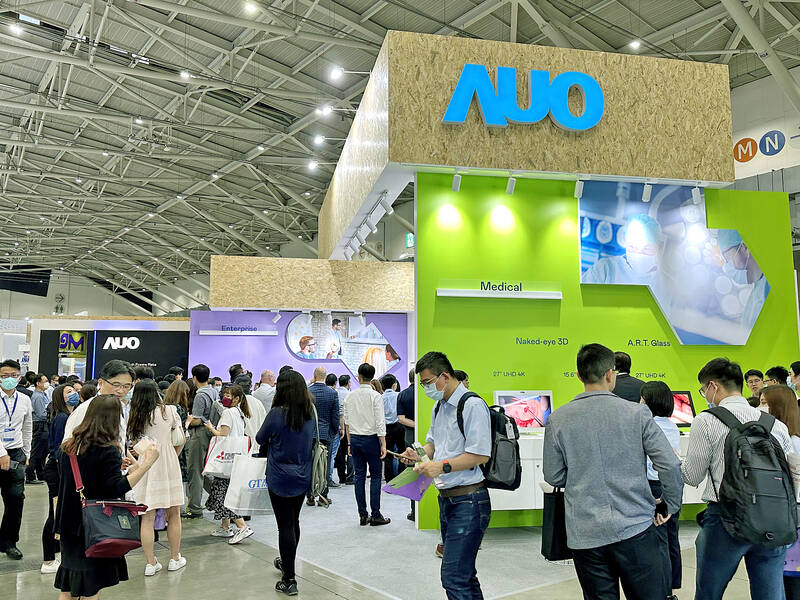Major Taiwanese LCD panel makers AUO Corp (友達) and Innolux Corp (群創) have a chance to swing back into the black in September ahead of their Chinese competitors, benefiting from further panel price hikes and free from heavy depreciation expenses, market researcher Omdia said.
The researcher expects the prices of TV panels to climb about 3 to 5 percent this month, extending a dramatic uptick in the first few months of this year, while the prices of panels used in computers and monitors have started picking up this month by about 3 percent.
Last month, manufacturers raised prices for computer and monitor panels on their distribution networks for the first time since the industry slump in the second half last year due to a severe surplus, Omdia said.

Photo: Chen Mei-ying, Taipei Times
“The price increases are mainly driven by a reduction in supply as panel manufacturers have been curbing factory utilization and some [companies in] South Korea shut down factories. Overall, end market demand remains tepid this year,” Omdia senior researcher David Hsieh (謝勤益) said on Thursday at its annual technology seminar in Taipei.
PC manufacturers are expected to replenish panel inventory in the second half, as Dell, HP and Lenovo are approaching the end of their inventory digestion cycle, the researcher said.
That was a stark difference from last summer when Samsung Electronics Co halted panel purchases, heralding the arrival of an oversupply-driven slump.
To eke out a profit, flat-panel makers lowered factory utilization rates for TV panels to about 80 percent, and 70 percent for computer and monitor panels, Hsieh said.
“The worst period for panel manufacturers has passed, but the best has yet to come,” he said. “The price increases will be mild this year. We do not rule out the possibility of a panel shortage next year as no new capacity has been installed over the past few years.”
It would take about two years for panel makers to ramp up new production lines, Hsieh said.
With panel production under strict control, total panel supply is forecast to drop 1.6 percent year-on-year, following the closures of some manufacturing facilities from LG Display, AUO and Innolux, while demand is expected to expand 4 percent, Hsieh said.
That meant the industry is on track for a supply-demand balance this year, the analyst said.
Taiwanese panel makers would see a quicker recovery as they have paid up almost all depreciation costs for manufacturing facilities, Hsieh said.
After a grueling oversupply problem, it might be hard to imagine that there might be a panel shortage next year, Hsieh said.
However, based on Omdia’s projection, global panel demand would expand 8 percent year-on-year next year, much faster than 2 percent projected growth in panel capacity, he said.
“We believe a new crystal cycle is restarting now,” Hsieh said. “Next year, TV replacement demand would fuel flat-panel demand significantly.”
AUO shares yesterday rallied 1.36 percent to NT$18.65, while the stock price of Innolux inched up 0.34 percent to NT$14.7. Smaller panel maker HannStar Display Corp’s (瀚宇彩晶) share price jumped 1.89 percent to NT$13.45. The TAIEX ended 0.27 percent lower yesterday.

CAUTIOUS RECOVERY: While the manufacturing sector returned to growth amid the US-China trade truce, firms remain wary as uncertainty clouds the outlook, the CIER said The local manufacturing sector returned to expansion last month, as the official purchasing managers’ index (PMI) rose 2.1 points to 51.0, driven by a temporary easing in US-China trade tensions, the Chung-Hua Institution for Economic Research (CIER, 中華經濟研究院) said yesterday. The PMI gauges the health of the manufacturing industry, with readings above 50 indicating expansion and those below 50 signaling contraction. “Firms are not as pessimistic as they were in April, but they remain far from optimistic,” CIER president Lien Hsien-ming (連賢明) said at a news conference. The full impact of US tariff decisions is unlikely to become clear until later this month

With an approval rating of just two percent, Peruvian President Dina Boluarte might be the world’s most unpopular leader, according to pollsters. Protests greeted her rise to power 29 months ago, and have marked her entire term — joined by assorted scandals, investigations, controversies and a surge in gang violence. The 63-year-old is the target of a dozen probes, including for her alleged failure to declare gifts of luxury jewels and watches, a scandal inevitably dubbed “Rolexgate.” She is also under the microscope for a two-week undeclared absence for nose surgery — which she insists was medical, not cosmetic — and is

GROWING CONCERN: Some senior Trump administration officials opposed the UAE expansion over fears that another TSMC project could jeopardize its US investment Taiwan Semiconductor Manufacturing Co (TSMC, 台積電) is evaluating building an advanced production facility in the United Arab Emirates (UAE) and has discussed the possibility with officials in US President Donald Trump’s administration, people familiar with the matter said, in a potentially major bet on the Middle East that would only come to fruition with Washington’s approval. The company has had multiple meetings in the past few months with US Special Envoy to the Middle East Steve Witkoff and officials from MGX, an influential investment vehicle overseen by the UAE president’s brother, the people said. The conversations are a continuation of talks that

Alchip Technologies Ltd (世芯), an application-specific integrated circuit (ASIC) designer specializing in artificial-intelligence (AI) chips, yesterday said that small-volume production of 3-nanometer (nm) chips for a key customer is on track to start by the end of this year, dismissing speculation about delays in producing advanced chips. As Alchip is transitioning from 7-nanometer and 5-nanometer process technology to 3 nanometers, investors and shareholders have been closely monitoring whether the company is navigating through such transition smoothly. “We are proceeding well in [building] this generation [of chips]. It appears to me that no revision will be required. We have achieved success in designing